| Along with the photography and wildlife, the other reason I go out into the wilds is to just enjoy the walk and exercise. One of my regular walks is along a tributary of the River Tyne, the Derwent and today I decided to do part of that walk. I wasn’t really planning on achieving any great photographs – at least of animals, as this normally requires staying patiently in one location and or a lot of luck. However, I decided to pack away my long lens, perhaps not the smartest move considering its weight and set off for my starting point just by Swalwell. |
| The first part of the journey was uneventful and wet after it started raining within 10 minutes of my starting. Every now and then I stopped and waited 20 minutes or so to see if any Kingfishers went by but at this time of the year they seem to be further up river. Also the harsh winter seems to have thinned out their numbers so there may be some Kingfisher real-estate still up for grabs. The only activity seemed to be a few other lost souls out for a walk and joggers. With the un-forecasted rain and darkening skies, I was starting to question the wisdom of going out for the day on a lengthy walk. Red marker showing the Derwent Railway Viaduct (see image map further down). |
Viewpoint looking up towards Swalwell |
| 
|
| Finally, the rain stopped and a first picture opportunity came along, two female Mallard ducks. Normally quiet shy, these two actually came towards me – of course it may have had something to do with my tucking into a sandwich. The water was very green and with the brightening light, made these images stand out. |
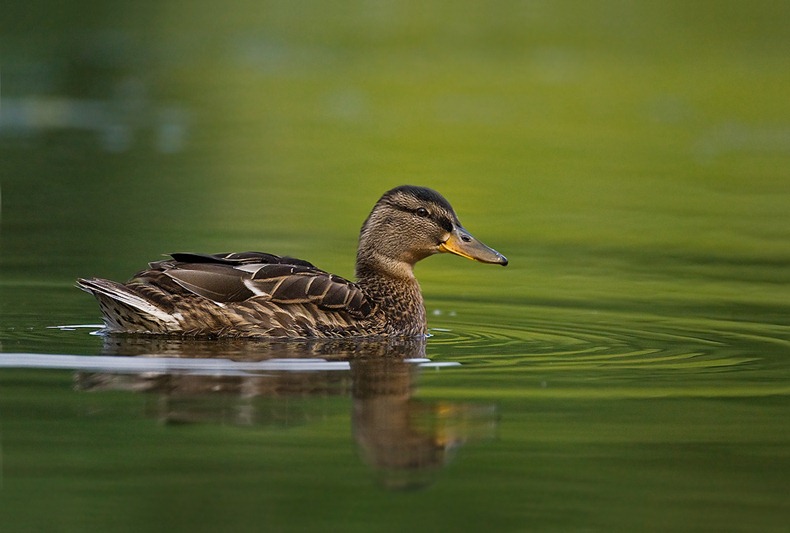 |
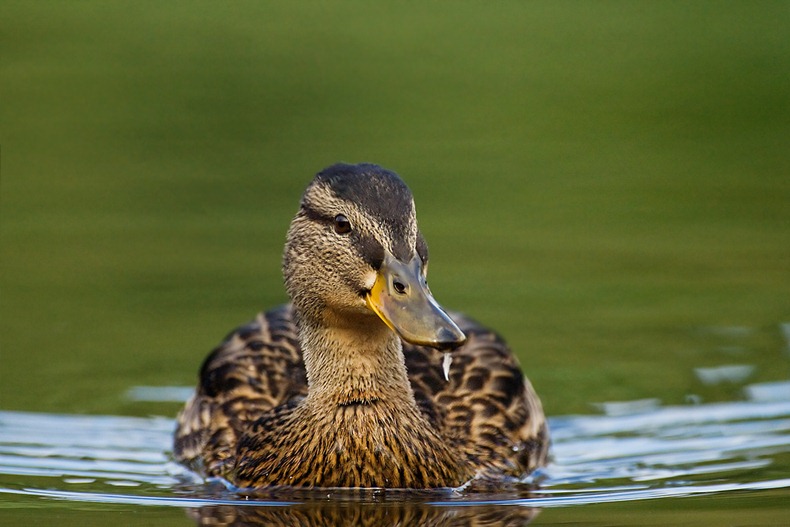 |
| After nearly two hours, I stopped at one of my favourite, reasonably secluded spots. Sit here long enough at the right time of year and you will almost certainly see a Kingfisher go flashing past and, if it’s not too overgrown on the banks, you can see it perching further upstream, though too far away to photography and inaccessible to get to. Dippers and Wagtails are also common flickering over the shallow waters. Sitting here quietly on previous occasions, I have also seen Sparrowhawks darting through the trees chasing its prey. From a photographers point of view, this part of the river is too dark to take successful photographs because of the overhanging trees. Even when the suns rays do stray onto the river it causes exposure problems due to extremes of dark areas and bright highlights. |
Just below the viaduct – a good place for Dippers and glimpses of Kingfishers |
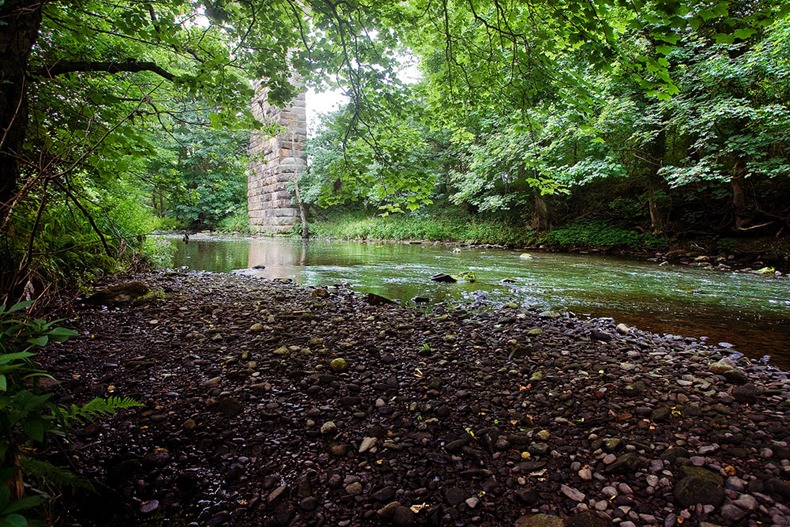 |
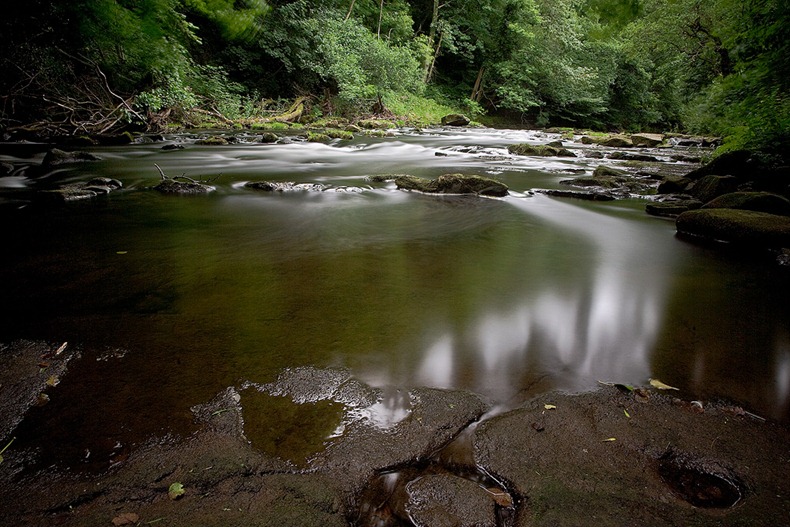 |
| Eventually along this stretch of the river there comes a point when you can no longer follow the path it follows and have to take a deviation. Just as I was approaching that point, at around midday, I saw something out of the corner of my eye which I thought was a large dog in some undergrowth. Seeing no owner around I started to take a closer look and out strolled a male Roe Deer across the path making its way down towards the river path I had just come from. |
| 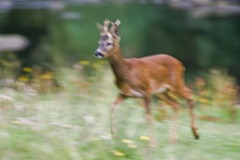 Having been taking some landscape shots and only just put back on my telephoto lens plus converter in readiness for what I thought would be my next opportunity – Kites – I still had my old settings on and surprised at seeing the animal at a place and time busy with dog walkers, I forgot to change the settings so the quick images I managed to get were hand held at a low shutter speed – 1/20th. Needless to say the images were just a smidgen blurry, (see left). Before I realised what I had done and could change it, the young buck had seen me and legged it. Trying to keep the obscenities at my bungling incompetency down to a quiet minimum, I proceeded on my way with my journey. Having been taking some landscape shots and only just put back on my telephoto lens plus converter in readiness for what I thought would be my next opportunity – Kites – I still had my old settings on and surprised at seeing the animal at a place and time busy with dog walkers, I forgot to change the settings so the quick images I managed to get were hand held at a low shutter speed – 1/20th. Needless to say the images were just a smidgen blurry, (see left). Before I realised what I had done and could change it, the young buck had seen me and legged it. Trying to keep the obscenities at my bungling incompetency down to a quiet minimum, I proceeded on my way with my journey.
|
|
Viewpoint from Derwent Railway Viaduct and some of the wildlife found there |
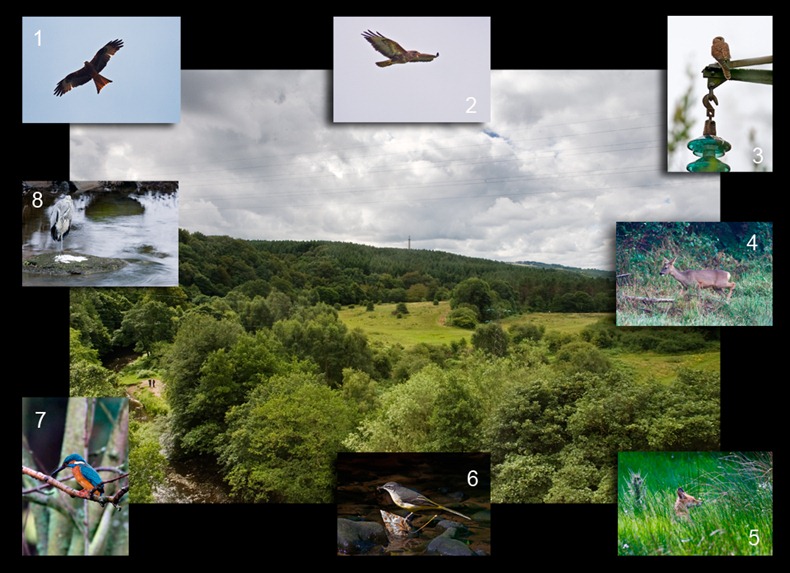 |
-
Red Kites – A popular place to see these birds of prey being reintroduced to the area of Gateshead back in 2004, regularly seen soaring high overhead. There has usually been a pair nesting in this area. -
Buzzards – Not as common as the Kites here. It seems that areas where there are Kites, Buzzards are rarer and vice versa, presumably because they are competing with each other. -
Kestrels – Along the open areas you will probably glimpse a Kestrel though seem sensitive to human disturbance. They can be seen perched along the pylons or hovering along the nearby main road. -
Roe Deer – These are found in the main woods along the Derwent and even sometimes venture out during the day when you will probably stumble across them. -
Red Fox – Mostly around at night, dusk or dawn as are also sensitive to humans. I have occasional stumbled across one in the middle of the day. Winter snow shows their numerous tracks around the area. -
Wagtails & Dippers – Easy to see though not to photograph due to the darker parts of the rivers they can be seen. Constantly on the move on the shallow parts of the river looking for insect larvae. -
Kingfishers – Usually only seen as a colourful flash past. Best seen during the summer months, though again, due to sensitivity to disturbance, you need to find somewhere on the quieter stretches to see in action. -
Herons – Can be seen patiently waiting for their prey to come into striking distance. They have a ‘comfort zone’ which as long as you stay out of, you can watch them.
|
| Climbing out of the valley there’s a point where I always stop in the hope of catching a Kite, which would be at eye level view, with a back drop of the woods. Not this time, but looking across the valley in the far distance I could see a speck which had the characteristic flight of a Kite – circular gliding pattern, slowly covering territory. Even at around 800mm, through my viewfinder the Kite was still a very small object but I could see it had seemed to be taking an interest at a spot above some Crows. This, however got their attention and, like all birds of prey, ended up being mobbed. I kept willing it to fly in my direction but instead it flew away to the north. |
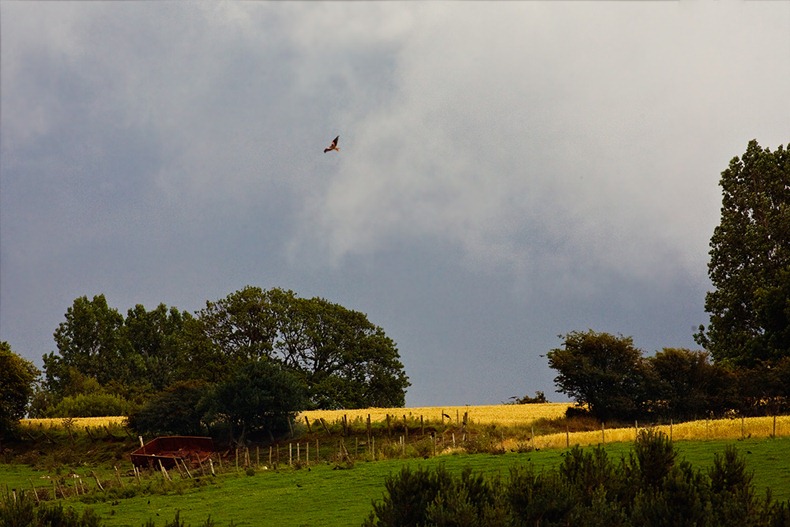 |
A view overlooking part of the Gibside Estate. the derwent continues between the trees in the foreground |
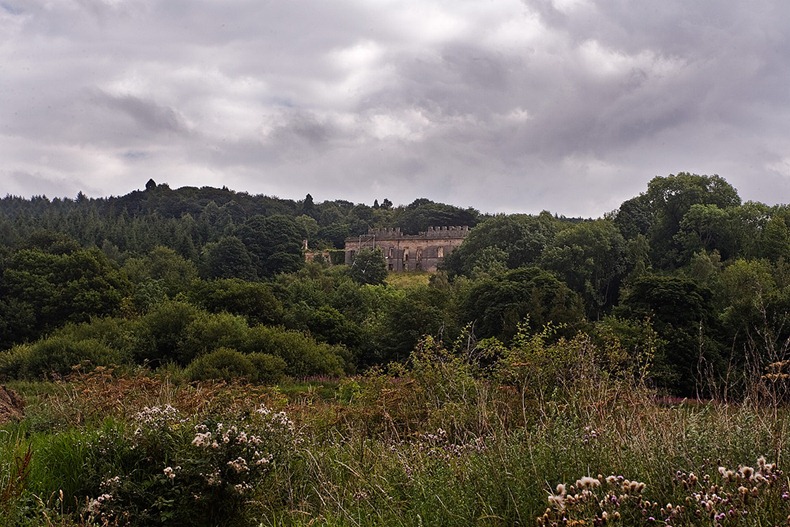 |
 Rather than continuing my journey by rejoining the Derwent and with darkening, foreboding skies, I decided to end it at the ‘Far Pastures Hide’. At the best of times, this hide overlooking a pond and reed beds surrounded by trees, is quiet, but at this time of year much of it is overgrown and with what little water that is open, covered in a film of weed. Today was no exception with little to be heard or seen. A Heron flew in but was soon lost in the dense reed bed and undergrowth. Judging by the odd splash, ripples and bubbles emanating from underneath the water, there was more going on under the surface than above. Five hours and about two and a half miles after the start of my journey, I decided to call it a day. The River Derwent itself continues onwards west reaching Consett and into the man made Derwent Reservoir ten plus miles away, but that’s for another day and a less weighty pack on my back. As is so often the case, I saw more during the day than was able to photograph and most of what I was able to photograph I deleted when I got home. |
0 comments:
Post a Comment